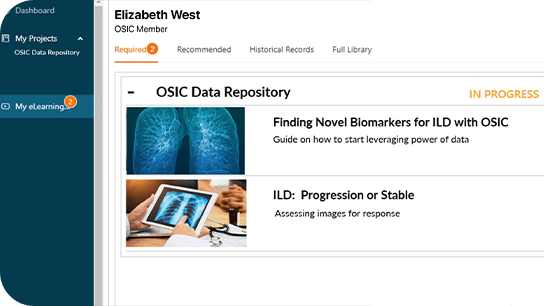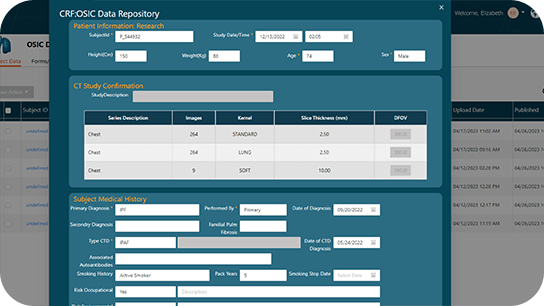The World's Largest and Most Diverse, Curated Global Data Repository for Interstitial Lung Diseases (ILDs)
|
The OSIC Cloud was built with the expertise and help of radiologists, pulmonologists, machine learners, and imaging experts from around the world. It is a data‑rich, curated repository of anonymized HRCT scans and clinical information regarding ILDs, and houses a plethora of real world clinical and imaging data that is both multi‑ethnic and multi‑center. One of the key features of the OSIC Cloud is its diverse and representative sample of anonymized patient cases. By including global data from multiple centers and ethnicities, the repository offers a more complete and realistic picture of ILDs than individual studies or datasets can provide.
The purpose of the OSIC Cloud is to provide researchers and clinicians with access to high‑quality data that can be used to advance our understanding of ILDs to help improve patient care. This allows researchers to analyze and compare imaging findings with clinical data, providing a more comprehensive understanding of ILDs. The data in the OSIC Cloud is carefully curated and quality controlled to ensure its reliability and accuracy. This makes the repository a valuable resource for machine learning and artificial intelligence technologies, which require large amounts of accurately‑labeled data to build algorithms. By providing access to anonymized, high‑quality, multi‑center data, this repository has the potential to advance research and improve patient outcomes in this important field of medicine. |
The technology is there to make advances in rare diseases, but many roadblocks exist that require momentum, brainpower and data to work through. A concerted effort from all stakeholders is needed to fully utilize the available technology and data in the fight against these diseases. This is an entire world problem, not just a first world country or regional issue and, working together, we will get there faster. It’s not possible to solve a heterogeneous disease with a homogeneous dataset — a collection of large and diverse real‑world data is needed. And with determination and cooperation, we believe we can achieve a future where healthcare is more efficient, effective and personalized for all patients.
It is our belief that this database could be the start of finding digital imaging biomarkers that could potentially speed up diagnosis, and aid in better understanding of individual prognosis and response to therapy. |
|
|
Building the OSIC repository has been a collaboration in its truest sense, with people from different disciplines, organizations, and countries all coming together on behalf of patients everywhere. This ability to collect and organize anonymized imaging and clinical data from across the world is the future of clinical science. We’ve seen efforts like this in common diseases, but nothing truly like it for rare diseases. As the OSIC database grows and we continuously learn from it, a real and substantial improvement in our ability to diagnose early, to predict outcomes, and to measure responses to therapy will be the result." Dr. Kevin Brown National Jewish Health, OSIC Pulmonology Lead |
Accessing the OSIC Cloud
|
If you are an OSIC member institution,
please register to receive access to the OSIC Cloud. |
Current OSIC Cloud Overview
|
COMMITTED DATA TO DATE
20,789 anonymized scans
with accompanying clinical data from Northern Europe, Western Europe, Central & Eastern Europe, North America, South America, Asia-Pacific (APAC) Committed goal surpassed: 15,000 anonymized scans |
AVAILABLE DATA TO OSIC MEMBERS
6,200+ anonymized scans
|
Platform Highlights
OSIC is committed to protecting the privacy and integrity of patient dataOSIC is committed to maintaining the highest level of data privacy and security in order to facilitate important research and advancements in the field of respiratory diseases. The OSIC Cloud was built with images and clinical data from a variety of sources, and every scan has been anonymized with a personal and automated quality control check.
The OSIC Cloud process has been vetted by two global GDPR/HIPAA privacy firms, has U.S. Central IRB (Advarra) and multiple institution IRB approvals, and is managed in compliance with all applicable privacy laws, regulations, consents and related restrictions. OSIC, as shown by our rigorous testing and compliance with GDPR and HIPAA requirements, is committed to protecting the privacy of patient data and the data integrity of all institutions who choose to partner with us. |
In recent years, we have seen rapid developments in advanced medical imaging analysis, but a major obstacle to harnessing this technology used to study pulmonary fibrosis is the lack of large diverse imaging repositories needed for computer training. OSIC addresses this unmet need by providing researchers with the data needed to develop AI-based applications for improving patient care and facilitating precision medicine. Being able to reliably predict how pulmonary fibrosis will progress in an individual patient would allow doctors to initiate appropriate treatment at the earliest opportunity and slow disease progression. It remains one of the most urgent challenges for effective management for patients with fibrotic lung disease." Dr. Simon Walsh National Heart and Lung Institute, Imperial College London |
The data-rich, heterogeneous OSIC Cloud can help change lives
|
What specific ILD does my patient have? How will my patient respond to a particular therapy? What course of treatment should I recommend for the best possible outcome?
These are just a sampling of the many questions healthcare professionals are faced with when treating ILD patients. Machine learning technology can help shed light on treatment decisions by developing universal and accessible algorithms to analyze patients’ digital data — ultimately leading to earlier diagnosis, enhanced prognosis, and improved management of disease.
The problem? No single center will ever have enough patients to supply the data required for progress. The OSIC Cloud is positioned to change this. Its large, heterogeneous database can help healthcare professionals build algorithms that will find answers and change lives. Its open science model–the science that OSIC creates will be shared with the world – is the best approach, and key to personalized treatment and drug development. To see the now available CenTime click here. To see how the OSIC data fuels innovation, register to watch our thought-provoking symposium at RSNA 2022 where we discussed how our members are “Powering Digital Imaging Biomarkers and AI for Rare Disease.” |
The future of medical research depends heavily on our ability to collate significant amounts of data, and make that data available for detailed and open scientific investigation. It's a proud moment that OSIC is at the forefront of this movement. Data is the essence of scientific progress and the OSIC repository already contains preliminary data rich enough to better understand the causes of disease, leading to better treatment and patient outcomes." Dr. David Barber University College London, OSIC Computational Science Lead |
If you are an OSIC member institution, please register to receive your credential to access the OSIC Cloud.
Not an OSIC member institution?
We encourage you to visit our membership page to learn more.
Not an OSIC member institution?
We encourage you to visit our membership page to learn more.









